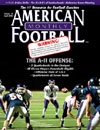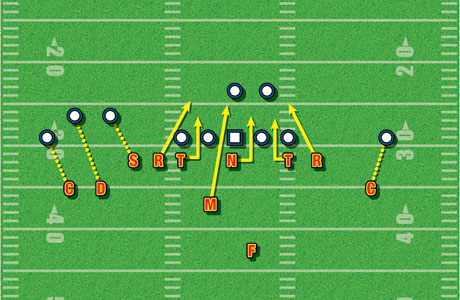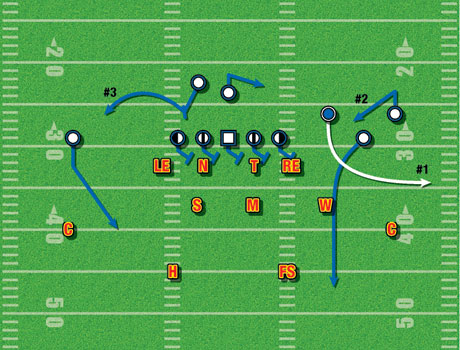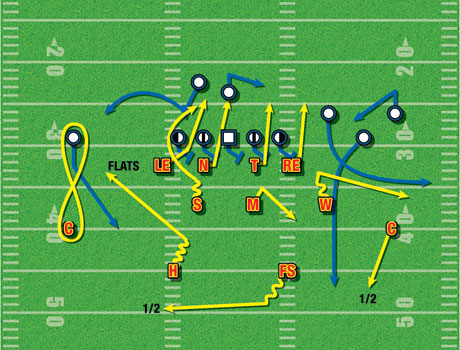AMERICAN FOOTBALL MONTHLY THE #1 RESOURCE FOR FOOTBALL COACHES
Article CategoriesAFM Magazine
|
The Situation© More from this issueYou’re on defense and have been effective with your 3-3-5 for most of the game. Your opponent’s high-powered offense has been held in check. They’re now at your 45-yard line and face a third and six at the right hash. The score is tied, 14-14, and it’s midway fourth quarter. For most of the game they've been using a no back set; on this play they line up with trips to the left and a single receiver to the right. How do you stop this potential pass play and force them to punt? John Wren, Head Coach, South Bakersfield High School, Bakersfield, CA. AFM subscriber since 2002. Given these circumstances, there is one key decision to make: Do you want to pressure an early throw or do you want to play with a four-man pressure and create an advantage in coverage? In our version of the 3-3-5, the answer always leans toward pressure, especially when the offense is relying on a single back and has no TE to utilize in their protection scheme. Once the decision to pressure is made, you need to look to create a plus-one pressure to the wide side of the field, designating the edge rusher with the responsibility of keeping the QB in the pocket. The free safety will push his alignment into the box and will play a wrap-around technique, matching the movements of the TB. The remaining coverage defenders will play a tight, man technique and will deny any inside release by the receivers. We would also have the option of holding the Mac linebacker out of the pressure scheme, using him in the wrap-around technique. This would enable us to play a true Cover 1, a bracket approach or a rolled Cover 3 coverage with the island corner locked up in man.
Bill Shepard, Former Head Coach, Rockford Christian Schools (IL). AFM subscriber since 2003. Our defense has been able to keep their offense out of the end zone most of the game. We have been playing a modified 3-3-5. We would normally play a 4-2-5 defense against any other passing team or we would play our Okie or 3-5-3 defense. But in this situation, we felt we needed extra defensive backs to combat their effective passing offense. They have been running motion from the non-trips side to help with protection and they’re also placing another receiver into the pass patterns. Now with a little more than six minutes to go, they’re shown us a new formation. It is likely they have been waiting for this exact moment to catch us off guard. We’ve instructed our players to be in base formation (42 slide strong with D twist cover blue) if any new formation is shown to us. We believe our opponent will try to clear the area with vertical patterns and come underneath for the needed yardage. It is important to continue to bring heat but it will come from a different direction with the hope of getting in front of the passing lanes and disrupting the timing of the passes. By playing the free safety and corner in deep halves, this should keep our opponent from launching the long ball and confuse the quarterback reads. Our D stunt will cause confusion in the overall blocking. It is important that the non-stunting inside LB drop to the middle zone a little deeper than normal. If pass shows, he’s looking for crossing routes. The strong safety and Will linebacker need to drop hard to the flats if pass is shown. For us, the flats are seven yards wide of the last man on the line of scrimmage, seven yards deep and to the sidelines. The corner away from the trips alignment is supposed to play man coverage but give the appearance he’s in zone. We have a greater opportunity to be aggressive and play tough against a new play and formation if our players are in a familiar defense. We need to stay aggressive, read our keys, tackle as a team and force the offense to alternate to what they are designed to do. This is how we stand a chance to force the punt and get the ball back.
The Situation... Coming in June: You’re on defense and have been effective with your 4-2-5. You just turned the ball over as your quarterback was intercepted for the second time in the first half. With the INT, your opponent has a first down on your 15-yard line. It’s late in the first half and the game is tied, 10-10. They come out in a shotgun spread with a 2 x 2 set. The ball is on the right hash. It looks like a pass play as the quarterback drops straight back. How do you stop this play and at least limit their momentum? Go to www.AmericanFootballMonthly.com/thesituation or send your response and play diagram to AFM's Managing Editor Rex Lardner at rlardner@lcclark.com. |
|
| HOME |
MAGAZINE |
SUBSCRIBE | ONLINE COLUMNISTS | COACHING VIDEOS |
Copyright 2024, AmericanFootballMonthly.com
All Rights Reserved







